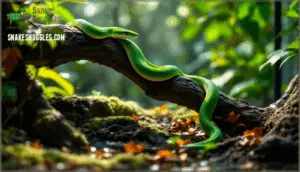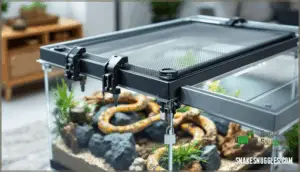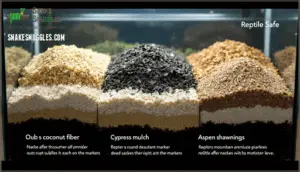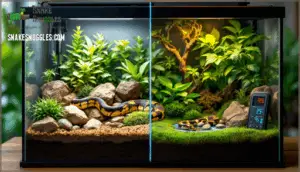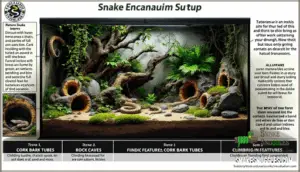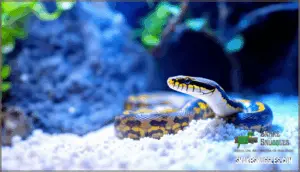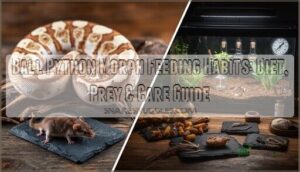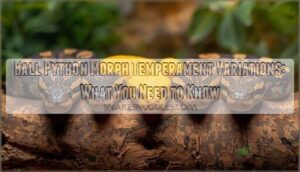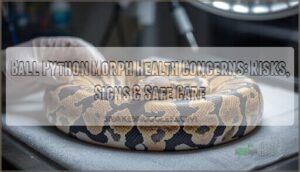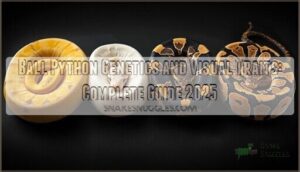This site is supported by our readers. We may earn a commission, at no cost to you, if you purchase through links.

Desert kingsnakes need bone-dry conditions that would dehydrate a rainbow boa within weeks, while tropical species require humidity levels that would breed bacteria in a temperate colubrid’s enclosure. Getting these details right from day one saves your snake from preventable health issues and eliminates costly trial-and-error down the line.
Table Of Contents
Key Takeaways
- Species-specific habitat requirements are non-negotiable, with differences between desert kingsnakes needing bone-dry conditions and tropical species requiring high humidity directly determining whether your snake thrives or develops preventable health issues like respiratory infections and shedding problems.
- Proper enclosure setup requires matching dimensions to adult size (minimum two-thirds the snake’s length), distinguishing between terrestrial species that need floor space with 4-6 inches of substrate depth versus arboreal species requiring 3-4 feet of vertical height with multiple climbing branches.
- Temperature gradients (88-92°F basking spot dropping to 78-80°F on the cool side) and species-specific humidity levels (40-60% for desert species, 60-80% for ball pythons) must be monitored with calibrated digital thermometers and hygrometers to enable proper thermoregulation and prevent metabolic dysfunction.
- Daily maintenance routines including waste removal, fresh water changes, and monthly complete substrate replacements with disinfection prevent bacterial growth, parasitic infestations, and stress-related illness that compromise your snake’s immune system within days of neglect.
Choosing The Right Enclosure Size
Getting the enclosure size right isn’t just about giving your snake room to move—it’s about matching their natural actions and adult dimensions. Whether you’re setting up for a ball python or a corn snake, the difference between terrestrial and arboreal needs changes everything.
Here’s what you need to think about when selecting an enclosure that keeps your snake both secure and comfortable.
Matching Enclosure Dimensions to Snake Size
Your snake’s adult length determines the absolute minimum enclosure footprint—but don’t fall into the trap of thinking "just big enough" means "good enough." Proper sizing accounts for growth rate, habits, and movement space.
Follow these benchmarks:
- Minimum enclosure size should equal two-thirds the snake’s total length
- Enclosure width must allow complete 180-degree body turns
- Snake length ratio of 1:1 fosters activity levels
- Vertical space becomes critical for semi-arboreal species
- Growth rate considerations prevent premature upgrades
Rectangular snake enclosures consistently outperform tall, narrow designs for terrestrial species.
Arboreal Vs. Terrestrial Species Needs
Whether your snake spends its life winding through branches or hugging the ground changes everything about how you’ll design its home. Arboreal species demand vertical space and climbing features, while terrestrial snakes prioritize floor area and substrate depth.
| Feature | Arboreal Species | Terrestrial Snakes |
|---|---|---|
| Enclosure Height | 3-4 feet minimum for adequate climbing space | 12-18 inches sufficient for most species |
| Branch Placement | Multiple horizontal and diagonal perches throughout | Optional; low branches only if semi-arboreal |
| Substrate Depth | 2-3 inches for waste management | 4-6 inches to support burrowing actions |
| Humidity Gradients | Vertical variation with moisture near bottom | Horizontal gradient from warm to cool side |
Secure Lids and Escape Prevention
Snakes are escape artists by nature, and even a small gap in your enclosure becomes an open invitation for them to explore beyond their home. Lid weight matters—lightweight mesh won’t cut it for determined snakes. You’ll need locking mechanisms on every access point, especially for larger species that can push against lids with surprising force.
Snakes are relentless escape artists—even a small gap or lightweight lid becomes an invitation to vanish beyond their enclosure
Choose materials with proven strength, seal all gaps, and consider childproofing enclosures if young family members are present. A secure enclosure protects your snake and creates a safe environment for proper snake care.
Selecting Safe and Effective Substrates
The substrate you choose sits at the foundation of your snake’s health—literally. It affects humidity retention, waste management, and even respiratory function.
Let’s walk through the options that work best for different species, what to avoid, and how to keep everything clean.
Recommended Substrate Types by Species
Matching substrate to species isn’t about personal preference—it’s about replicating the forest floor, desert sand, or grassland your snake’s ancestors evolved to thrive on. Choosing appropriate substrates means considering species-specific needs and habits:
- Aspen shavings work well for corn snakes and milk snakes that burrow frequently.
- Coconut fiber provides humidity retention for ball pythons and tropical species.
- Recycled paper bedding suits beginner setups across most snake species.
- Reptile bark mimics natural environments for terrestrial colubrids.
Your substrate selection directly impacts your snake’s comfort and health.
Substrate Safety and Allergen Concerns
Beyond choosing the right material, you’ll need to weigh hidden dangers lurking in substrate selection. Chemical contaminants like PCBs and organochlorine pesticides accumulate in commercial beddings, with concentrations reaching 3.49–7.01 ppm in snake shed samples. Dust allergens from aspen and kiln-dried wood trigger respiratory inflammation, while mold growth in humid substrates harbors fungal spores linked to snake fungal disease. Pathogen accumulation in moisture-retaining materials increases Salmonella risk and skin infections.
Safe substrates like paper and sterilized coconut fiber minimize these threats, but toxic substrates demand careful scrutiny of safety data sheets before use. Considering species-specific needs, aspen bedding is suitable for snakes like cornsnakes and ratsnakes.
| Substrate Concern | Common Sources | Health Impact |
|---|---|---|
| Chemical Contaminants | Commercial bark, treated wood | Immune suppression, skin irritation |
| Dust Allergens | Aspen shavings, kiln-dried substrates | Respiratory inflammation, lethargy |
| Mold Growth | Organic mulches, sphagnum moss | Fungal infections, dermatitis |
| Pathogen Accumulation | Moisture-retaining beddings | Bacterial infections, gastrointestinal disease |
Substrate Maintenance and Replacement
Your snake’s substrate isn’t a "set it and forget it" situation—neglecting regular maintenance creates a breeding ground for bacteria, parasites, and respiratory problems. Safe substrates require consistent upkeep to prevent pathogen buildup and odor control issues.
Follow these substrate maintenance guidelines:
- Waste Removal: Spot-clean feces and urates daily using tweezers or gloves
- Substrate Depth: Maintain 2-3 inches for burrowing species; replace when compacted
- Parasite Prevention: Full substrate replacement every 4-6 weeks minimizes mite colonization
- Odor Control: Change substrate immediately if ammonia smell develops
- Disposal Methods: Seal used substrate in bags; never reuse even with sterilization attempts
Substrate selection impacts replacement frequency—paper bedding requires weekly changes, while coconut fiber lasts longer with proper spot-cleaning.
Managing Temperature and Humidity Requirements
Getting your snake’s temperature and humidity right isn’t guesswork—it’s the difference between a thriving pet and a stressed one. Different species have wildly different needs, from desert dwellers to rainforest natives.
Here’s what you need to know to nail the climate control in your snake’s enclosure.
Creating Thermal Gradients
A thermal gradient isn’t just a luxury—it’s the difference between a thriving snake and one struggling to regulate its most basic metabolic functions.
Position your heat source at one end to create a warm basking spot of 88-92°F, letting the opposite side cool to 78-80°F. This temperature gradient allows proper thermoregulation.
Use digital thermometers at both ends and calibrate your thermostat regularly to maintain consistent thermal zones.
Species-Specific Humidity Levels
Getting humidity levels wrong is like asking a desert lizard to live in a rainforest—it won’t end well. Species-specific humidity requirements vary dramatically based on species origins. Ball pythons need 60-80% humidity, while corn snakes thrive at 65-75%. Desert snakes like kingsnakes require just 40-60%.
Maintaining ideal humidity levels prevents shedding problems and promotes respiratory health. Use hygrometers for humidity monitoring and adjust humidity control methods accordingly—whether that’s misting, humid hides, or moisture-retentive substrates. Corn snakes also benefit from a temperature gradient to properly thermoregulate.
Monitoring Tools for Climate Control
Without accurate monitoring tools, you’re basically flying blind—guessing at conditions that could mean life or death for your snake.
Digital hygrometers and thermometers provide precise temperature and humidity readings. Programmable thermostats maintain consistent thermal gradients through automatic adjustments. Remote monitoring systems send alerts when conditions drift outside safe parameters.
Data logging tracks patterns over time, helping you spot problems before they escalate. Thermostat calibration and hygrometer accuracy checks make certain your readings stay reliable.
Providing Lighting and Photoperiods
Light isn’t just about seeing your snake—it’s about keeping their internal clock running smoothly. Most snakes don’t need complex lighting setups, but getting the basics right makes a real difference in their conduct and health.
Here’s what you need to know about lighting types, UVB requirements, and daily light schedules.
Appropriate Lighting Types
Most snakes don’t need complex lighting setups, but choosing the right type can make a real difference in maintaining their day-night rhythm and overall well-being. Here are your primary lighting options:
- Low-wattage LED fixtures – Energy-efficient and produce minimal heat while establishing day-night cycles
- Fluorescent bulbs – Provide consistent lighting patterns without excessive warmth
- Ceramic heat emitters – Deliver heat without light, useful for nighttime temperature maintenance
- Heat lamps – Combine warmth and illumination for basking species
- UVB lighting – Optional for most species but may offer UVB benefits for certain snakes
Choose fixtures that support stable light cycles and match your snake’s natural lighting spectrum requirements.
UVB Needs for Different Species
While UVB lighting isn’t a requirement for most pet snakes, some species benefit from low-level exposure that mimics the filtered sunlight they’d encounter in their natural habitats. Diurnal species like garter snakes and some rat snakes show basking actions that suggests UVB benefits, while nocturnal pythons and boas have minimal UVB requirements.
If you’re using UVB lighting, limit duration to 10-12 hours daily and avoid supplementation risks from overexposure, which can damage eye tissue.
Establishing Consistent Light Cycles
Beyond selecting the right bulbs and duration, your snake needs a predictable day-night rhythm that mirrors natural seasonal patterns. Use timers to automate lighting schedules—consistency reinforces circadian rhythms and reduces stress.
A standard 12-hour day-night cycle works year-round for tropical species, while temperate snakes benefit from seasonal variation: slightly longer photoperiods in summer, shorter in winter. This mimics their natural environment and healthy physiological cycles.
Adding Hiding Spots and Climbing Features
Your snake needs places to feel safe and opportunities to move naturally. Think of hide spots as their refuge zones and climbing features as their gym.
Here’s how to set up both correctly.
Designing Hide Spots for Security
Since your snake’s sense of security hinges on access to appropriate shelter, you’ll need to provide at least two hide spots—one positioned on the warm side and another on the cool side of the enclosure. These reptile hides should fit snugly without cramping your snake—openings just large enough for entry work best.
Use safe materials like resin, cork bark, or PVC when creating naturalistic hiding places. Avoid sharp edges or unstable structures.
For species requiring elevated humidity, you can create humidity hides using moist sphagnum moss inside a plastic container with an access hole.
Climbing Structures for Enrichment
Arboreal and semi-arboreal species thrive when you add climbing structures that mimic their natural canopy environment. Use branches with varied textures and diameters—cork bark, grapewood, and PVC pipes work well. Secure mounting prevents collapse during active climbing.
Branch placement should accommodate species agility, creating vertical pathways for snake enrichment structures. Avoid sharp edges or unstable materials.
These climbing features provide essential environmental enrichment, allowing arboreal species to express natural actions while reducing stress.
Safe Decor and Environmental Enrichment
Choose non-toxic decor that won’t trap, injure, or stress your snake while delivering the mental stimulation every captive reptile needs. Artificial silk plants avoid decor material toxicity while adding visual complexity.
Naturalistic bioactivity elements like leaf litter encourage exploration. Rotate enrichment item safety-approved objects—smooth stones, PVC tubes, or conservation-based decor—to maintain cognitive snake stimulation.
Periodically rearrange hiding spots and climbing features to refresh environmental enrichment without overwhelming your animal.
Maintaining Health and Clean Habitat Conditions
A clean habitat isn’t just about appearance—it’s your first line of defense against respiratory infections, parasites, and stress-related illness. Regular maintenance routines keep your snake healthy while preventing problems before they start.
Here’s what you need to focus on to maintain ideal conditions in your snake’s enclosure.
Cleaning and Disinfection Routines
A dirty enclosure isn’t just unsightly—it’s a breeding ground for respiratory infections, scale rot, and parasitic infestations that can compromise your snake’s immune system within days.
Daily waste removal is your first line of defense. Remove feces immediately using tongs or gloves. Replace water bowls daily to prevent bacterial growth.
Perform complete substrate changes monthly, disinfecting surfaces with diluted bleach solutions or reptile-safe cleaners. This routine schedule guarantees proper hygiene and parasite prevention without exposing your snake to harsh chemicals.
Monitoring for Stress and Health Issues
Your snake’s actions are telling you its story—if you know what signs to watch. Stress manifests in hiding more than 90% of the time, reduced tongue flicking, and repetitive pacing along glass walls.
Watch for these critical health indicators:
- Shedding difficulties or incomplete skin retention signals humidity problems or mite infestations
- Refusal to eat for more than two feeding cycles may indicate stress-induced immune compromise
- Open-mouth breathing or excessive mucus suggests respiratory infections linked to chronic stress
Parasite infestations like Ophionyssus mites worsen stress responses and cause anemia. Schedule annual veterinary checkups to catch subclinical conditions before they escalate.
Husbandry impacts—inconsistent photoperiods, inadequate hides, or temperature fluctuations—directly trigger stress and disease.
Water Quality and Hydration Needs
Fresh water isn’t optional—dehydration stresses your snake’s kidneys faster than most environmental mistakes you’ll make. Choose shallow bowls wide enough for partial submersion. Water cleanliness matters—bacterial growth accelerates within 24 hours. Change water daily using dechlorinated or bottled water.
Monitor hydration signs like sunken eyes or wrinkled skin. Species requiring higher humidity benefit from periodic misting frequency adjustments. Your water source directly impacts your snake’s hydration habits and overall water quality maintenance.
Frequently Asked Questions (FAQs)
What diseases commonly affect captive snake populations?
Captive snakes commonly develop respiratory infections, scale rot, parasites, mouth rot, and inclusion body disease. Poor husbandry—like inadequate temperature or humidity—drives most reptile health problems, making preventive care critical for snake health.
How often should snakes be fed appropriately?
Like Odysseus steering between Scylla and Charybdis, you’ll balance feeding frequency with prey size and snake age.
Feeding schedule depends on species variations: juveniles eat weekly, adults biweekly to monthly. Activity level and shedding cycle affect appetite, so adjust accordingly.
Can multiple snakes cohabitate in one enclosure?
Most snake species shouldn’t cohabitate due to Species Compatibility issues, Cannibalism Risks, Resource Competition, and Stress Factors. Separate enclosures guarantee proper snake care, ethical ownership, stress reduction, and allow Quarantine Protocols when monitoring habitat requirements and health concerns for individual snake species.
What signs indicate a snake is preparing shed?
Oddly, your snake becomes less striking just before revealing its most impressive transformation. Eye Opacity appears as a milky-blue film, while Skin Dullness gives the body a faded appearance.
Actions include increased hiding and irritability. Reduced Appetite is common during the shedding process, safeguarding snake welfare throughout this vulnerable period.
How do you safely transport snakes externally?
Use a secure travel enclosure setup with proper ventilation holes. Maintain temperature regulation using heat packs or insulated containers. Minimize transport duration and stress through careful emergency planning.
Protect snake welfare by avoiding excessive contact. Safe decor inside prevents injury, protecting snake health throughout the journey.
Conclusion
Picture a ball python coiled beneath a heat lamp set ten degrees too high, its scales dulled from chronic dehydration. That’s what happens when you skip species-specific research.
Mastering snake species habitat needs means your animal sheds cleanly, maintains appetite, and lives decades instead of struggling through preventable illness. Match the enclosure to the biology—not the other way around.
Your snake’s health depends on parameters measured in degrees and percentage points, and those numbers aren’t negotiable.
- https://petadvocacy.org/wp-content/uploads/2022/01/Snakes-Care-Sheet.pdf
- https://redinational.com/what-factors-attract-snakes-to-residential-areas/
- https://aaacwildliferemoval.com/blog/snakes/a-snakes-habitat/
- https://talis-us.com/blogs/news/snake-in-a-cage-understanding-the-habitat-needs-of-pet-snakes
- https://ufwildlife.ifas.ufl.edu/pdfs/GabeMillerUFThesis2008.pdf

